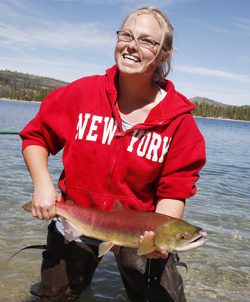forum
library
tutorial
contact

Rare Salmon Get Boost at Redfish
by Jon DuvalIdaho Mountain Express, September 11, 2009
|
the film forum library tutorial contact |

|
Rare Salmon Get Boost at Redfishby Jon DuvalIdaho Mountain Express, September 11, 2009 |
Sockeye released into lake after second summer of high returns
 While the summer crowds might have departed, Redfish Lake received an influx of visitors this week whose offspring will stick around long after the last RV has driven away.
While the summer crowds might have departed, Redfish Lake received an influx of visitors this week whose offspring will stick around long after the last RV has driven away.
On Tuesday and Wednesday, Idaho Fish and Game personnel, along with representatives from the Bonneville Power Administration, the National Oceanic and Atmospheric Administration, and the Shoshone-Bannock tribes of Idaho, released about 450 sockeye salmon into the lake near Stanley. The release caps off the second consecutive summer of unprecedented high sockeye returns.
On Wednesday, with about 30 people watching from the public boat ramp on the west side of Redfish Lake, Eagle hatchery Conservation Hatcheries Supervisor Jeff Heindel pulled the first sockeye from a specialized transportation truck and released it into the lake, noting the importance of the event.
"This is an important day and no one has seen a sight like this since 1956," Heindel said. "We've come a long way since 1991, when we started this program and only one female and three males came back."
Mike Peterson, a field biologist with Fish and Game, said about 730 "red fish" have arrived at two fish traps on the Salmon River, at the Sawtooth Fish Hatchery or near the mouth of Redfish Lake Creek. Heindel said he anticipates that another 50 to 100 fish will return throughout the month.
Last summer, 636 of the fish-sporting the classic green head and red-bodied look of spawning sockeye-arrived home to the high-elevation valley.
The two runs more than surpass the recent high of 257 sockeye that came back in 2000, which was the next highest return since 1985. And it's far more than the four sockeye that came back in 2007. Between 1991 and 1998, a total of just 16 sockeye returned to Redfish Lake.
The anadromous fish, which live in the ocean and swim upriver to breed in fresh water, are unequaled in that they travel to the highest elevation, over 6,500 feet, and run the longest distance, about 900 miles down the Salmon, Snake and Columbia rivers to the Pacific Ocean.
After spending about two years in the ocean, the fish then make the return journey to where they were hatched.
"These are the Lance Armstrong of sockeye," Heindel said.
Heindel said the back-to-back positive returns of the iconic fish of the Sawtooth Valley are largely the result of increased smolt production at Fish and Game's captive rearing program. He said positive river flows and good ocean conditions have also given the fish a boost in recent years. Peterson said that next week Fish and Game will release about 600 captive fish bred at the Eagle Fish Hatchery and the Burley Creek Hatchery in Washington.
Heindel said that toward the end of the month, the sockeye will make their way to a spawning ground at the southern end of the lake where the bottom is less sandy than where they were released. The fish will then spawn along the lakeshore in October, with the offspring, or smolts, emerging next spring.
The smolts will spend one or two years in the lake before migrating to the ocean. Those fish are expected to return to the lake between 2012 and 2014.
The existing adults die and decompose after spawning, helping add nutrients to the lake.
Despite the increase in numbers, Heindel said, recovery is still a ways away.
"We're careful not to get too excited," he said. "When we see 2,500 sockeye spawning naturally, that would be recovery."
During the past few springs, Idaho's hatchery program has released between 150,000 and 175,000 sockeye smolts. The young fish are kept in captivity as long as possible to give them a better chance of surviving the long voyage.
Heindel said the rate of survival for fish to return as spawning adults is about 1 percent.
learn more on topics covered in the film
see the video
read the script
learn the songs
discussion forum
